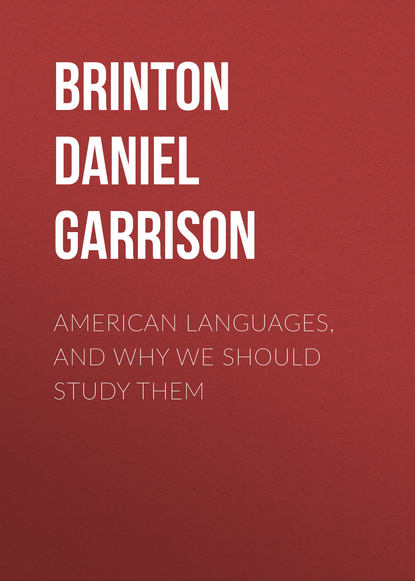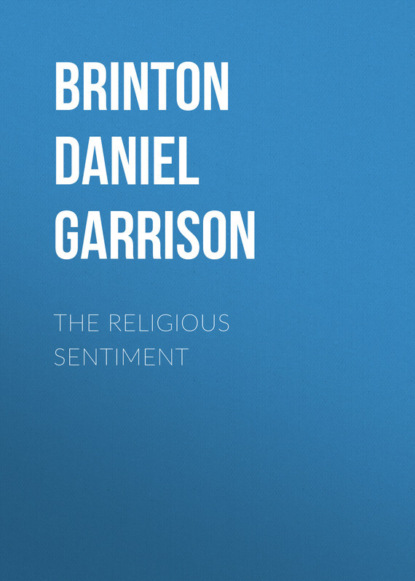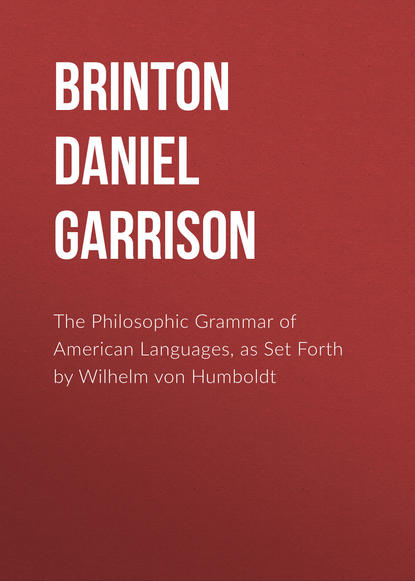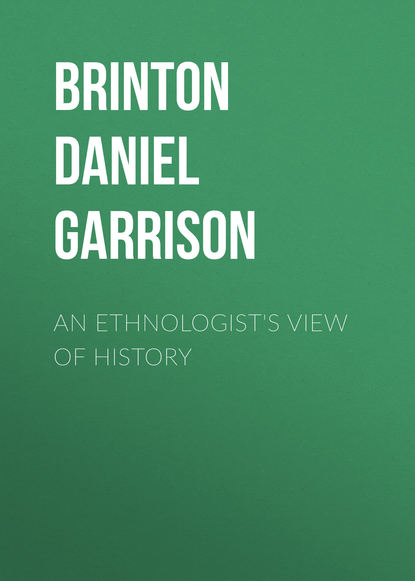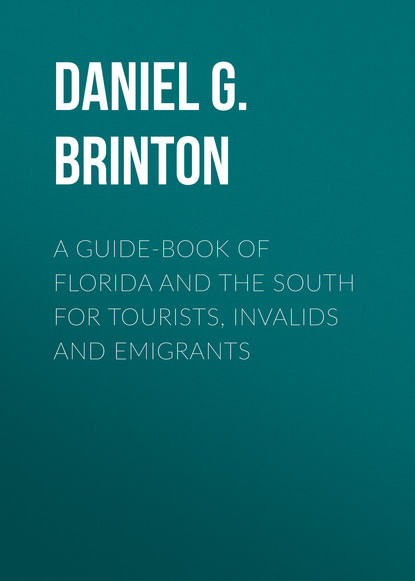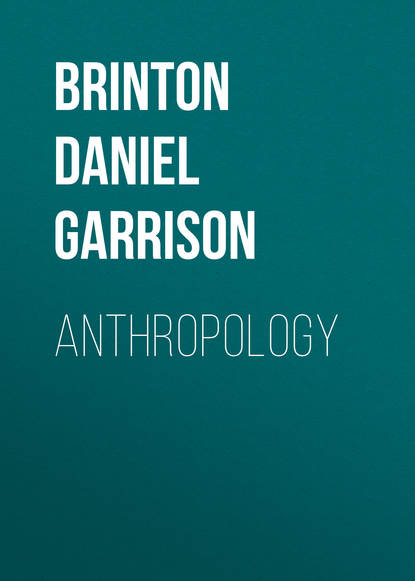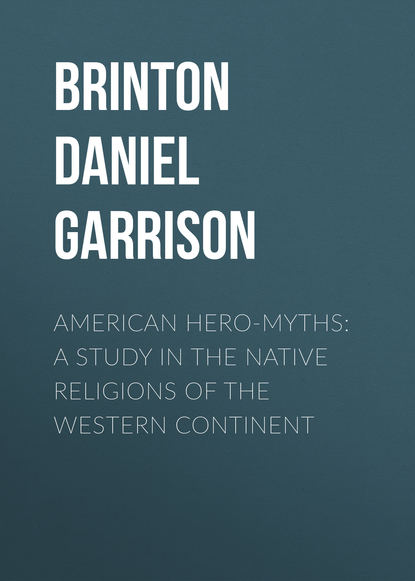
Полная версия
The Myths of the New World
These movements took place not in large bodies under the stimulus of a settled purpose, but step by step, family by family, as the older hunting grounds became too thickly peopled. This fact hints unmistakably at the gray antiquity of the race. It were idle even to guess how great this must be, but it is possible to set limits to it in both directions. On the one hand, not a tittle of evidence is on record to carry the age of man in America beyond the present geological epoch. Dr. Lund examined in Brazil more than eight hundred caverns, out of which number only six contained human bones, and of these six only one had with the human bones those of animals now extinct. Even in that instance the original stratification had been disturbed, and probably the bones had been interred there.27 This is strong negative evidence. So in every other example where an unbiased and competent geologist has made the examination, the alleged discoveries of human remains in the older strata have proved erroneous.
The cranial forms of the American aborigines have by some been supposed to present anomalies distinguishing their race from all others, and even its chief families from one another. This, too, falls to the ground before a rigid analysis. The last word of craniology, which at one time promised to revolutionize ethnology and even history, is that no one form of the skull is peculiar to the natives of the New World; that in the same linguistic family one glides into another by imperceptible degrees; and that there is as much diversity, and the same diversity among them in this respect as among the races of the Old Continent.28 Peculiarities of structure, though they may pass as general truths, offer no firm foundation whereon to construct a scientific ethnology. Anatomy shows nothing unique in the Indian, nothing demanding for its development any special antiquity, still less an original diversity of type.
On the other hand, the remains of primeval art and the impress he made upon nature bespeak for man a residence in the New World coeval with the most distant events of history. By remains of art I do not so much refer to those desolate palaces which crumble forgotten in the gloom of tropical woods, nor even the enormous earthworks of the Mississippi valley covered with the mould of generations of forest trees, but rather to the humbler and less deceptive relics of his kitchens and his hunts. On the Atlantic coast one often sees the refuse of Indian villages, where generation after generation have passed their summers in fishing, and left the bones, shells, and charcoal as their only epitaph. How many such summers would it require for one or two hundred people to thus gradually accumulate a mound of offal eight or ten feet high and a hundred yards across, as is common enough? How many generations to heap up that at the mouth of the Altamaha River, examined and pronounced exclusively of this origin by Sir Charles Lyell,29 which is about this height, and covers ten acres of ground? Those who, like myself, have tramped over many a ploughed field in search of arrow-heads must have sometimes been amazed at the numbers which are sown over the face of our country, betokening a most prolonged possession of the soil by their makers. For a hunting population is always sparse, and the collector finds only those arrow-heads which lie upon the surface.
Still more forcibly does nature herself bear witness to this antiquity of possession. Botanists declare that a very lengthy course of cultivation is required so to alter the form of a plant that it can no longer be identified with the wild species; and still more protracted must be the artificial propagation for it to lose its power of independent life, and to rely wholly on man to preserve it from extinction. Now this is precisely the condition of the maize, tobacco, cotton, quinoa, and mandioca plants, and of that species of palm called by botanists the Gulielma speciosa; all have been cultivated from immemorial time by the aborigines of America, and, except cotton, by no other race; all no longer are to be identified with any known wild species; several are sure to perish unless fostered by human care.30 What numberless ages does this suggest? How many centuries elapsed ere man thought of cultivating Indian corn? How many more ere it had spread over nearly a hundred degrees of latitude, and lost all semblance to its original form? Who has the temerity to answer these questions? The judicious thinker will perceive in them satisfactory reasons for dropping once for all the vexed inquiry, “how America was peopled,” and will smile at its imaginary solutions, whether they suggest Jews, Japanese, or, as the latest theory is, Egyptians.
While these and other considerations testify forcibly to that isolation I have already mentioned, they are almost equally positive for an extensive intercourse in very distant ages between the great families of the race, and for a prevalent unity of mental type, or perhaps they hint at a still visible oneness of descent. In their stage of culture, the maize, cotton, and tobacco could hardly have spread so widely by commerce alone. Then there are verbal similarities running through wide families of languages which, in the words of Professor Buschmann, are “calculated to fill us with bewildering amazement,”31 some of which will hereafter be pointed out; and lastly, passing to the psychological constitution of the race, we may quote the words of a sharp-sighted naturalist, whose monograph on one of its tribes is unsurpassed for profound reflections: “Not only do all the primitive inhabitants of America stand on one scale of related culture, but that mental condition of all in which humanity chiefly mirrors itself, to wit, their religious and moral consciousness, this source of all other inner and outer conditions, is one with all, however diverse the natural influences under which they live.”32
Penetrated with the truth of these views, all artificial divisions into tropical or temperate, civilized or barbarous, will in the present work, so far as possible, be avoided, and the race will be studied as a unit, its religion as the development of ideas common to all its members, and its myths as the garb thrown around these ideas by imaginations more or less fertile, but seeking everywhere to embody the same notions.
BIBLIOGRAPHICAL NOTEAs the subject of American mythology is a new one to most readers, and as in its discussion everything depends on a careful selection of authorities, it is well at the outset to review very briefly what has already been written upon it, and to assign the relative amount of weight that in the following pages will be given to the works most frequently quoted. The conclusions I have arrived at are so different from those who have previously touched upon the topic that such a step seems doubly advisable.
The first who undertook a philosophical survey of American religions was Dr. Samuel Farmer Jarvis, in 1819 (A Discourse on the Religion of the Indian Tribes of North America, Collections of the New York Historical Society, vol. iii., New York, 1821). He confined himself to the tribes north of Mexico, a difficult portion of the field, and at that time not very well known. The notion of a state of primitive civilization prevented Dr. Jarvis from forming any correct estimate of the native religions, as it led him to look upon them as deteriorations from purer faiths instead of developments. Thus he speaks of them as having “departed less than among any other nation from the form of primeval truth,” and also mentions their “wonderful uniformity” (pp. 219, 221).
The well-known American ethnologist, Mr. E. G. Squier, has also published a work on the subject, of wider scope than its title indicates (The Serpent Symbol in America, New York, 1851). Though written in a much more liberal spirit than the preceding, it is wholly in the interests of one school of mythology, and it the rather shallow physical one, so fashionable in Europe half a century ago. Thus, with a sweeping generalization, he says, “The religions or superstitions of the American nations, however different they may appear to the superficial glance, are rudimentally the same, and are only modifications of that primitive system which under its physical aspect has been denominated Sun or Fire worship” (p. 111). With this he combines the favorite and (may I add?) characteristic French doctrine, that the chief topic of mythology is the adoration of the generative power, and to rescue such views from their materializing tendencies, imagines to counterbalance them a clear, universal monotheism. “We claim to have shown,” he says (p. 154), “that the grand conception of a Supreme Unity and the doctrine of the reciprocal principles existed in America in a well defined and clearly recognized form;” and elsewhere that “the monotheistic idea stands out clearly in all the religions of America” (p. 151).
If with a hope of other views we turn to our magnificent national work on the Indians (History, Conditions, and Prospects of the Indian Tribes of the United States: Washington, 1851-9), a great disappointment awaits us. That work was unfortunate in its editor. It is a monument of American extravagance and superficiality. Mr. Schoolcraft was a man of deficient education and narrow prejudices, pompous in style, and inaccurate in statements. The information from original observers it contains is often of real value, but the general views on aboriginal history and religion are shallow and untrustworthy in the extreme.
A German professor, Dr. J. G. Müller, has written quite a voluminous work on American Primitive Religions (Geschichte der Amerikanischen Ur-religionen, pp. 707: Basel, 1855). His theory is that “at the south a worship of nature with the adoration of the sun as its centre, at the north a fear of spirits combined with fetichism, made up the two fundamental divisions of the religion of the red race” (pp. 89, 90). This imaginary antithesis he traces out between the Algonkin and Apalachian tribes, and between the Toltecs of Guatemala and the Aztecs of Mexico. His quotations are nearly all at second hand, and so little does he criticize his facts as to confuse the Vaudoux worship of the Haitian negroes with that of Votan in Chiapa. His work can in no sense be considered an authority.
Very much better is the Anthropology of the late Dr. Theodore Waitz (Anthropologie der Naturvœlker: Leipzig, 1862-66). No more comprehensive, sound, and critical work on the indigenes of America has ever been written. But on their religions the author is unfortunately defective, being led astray by the hasty and groundless generalizations of others. His great anxiety, moreover, to subject all moral sciences to a realistic philosophy, was peculiarly fatal to any correct appreciation of religious growth, and his views are neither new nor tenable.
For a different reason I must condemn in the most unqualified manner the attempt recently made by the enthusiastic and meritorious antiquary, the Abbé E. Charles Brasseur (de Bourbourg), to explain American mythology after the example of Euhemerus, of Thessaly, as the apotheosis of history. This theory, which has been repeatedly applied to other mythologies with invariable failure, is now disowned by every distinguished student of European and Oriental antiquity; and to seek to introduce it into American religions is simply to render them still more obscure and unattractive, and to deprive them of the only general interest they now have, that of illustrating the gradual development of the religious ideas of humanity.
But while thus regretting the use he has made of them, all interested in American antiquity cannot too much thank this indefatigable explorer for the priceless materials he has unearthed in the neglected libraries of Spain and Central America, and laid before the public. For the present purpose the most significant of these is the Sacred National Book of the Quiches, a tribe of Guatemala. This contains their legends, written in the original tongue, and transcribed by Father Francisco Ximenes about 1725. The manuscripts of this missionary were used early in the present century, by Don Felix Cabrera, but were supposed to be entirely lost even by the Abbé Brasseur himself in 1850 (Lettre à M. le Duc de Valmy, Mexique, Oct. 15, 1850). Made aware of their importance by the expressions of regret used in the Abbé’s letters, Dr. C. Sherzer, in 1854, was fortunate enough to discover them in the library of the University of San Carlos in the city of Guatemala. The legends were in Quiche with a Spanish translation and scholia. The Spanish was copied by Dr. Scherzer and published in Vienna, in 1856, under the title Las Historias del Origen de los Indios de Guatemala, por el R. P. F. Francisco Ximenes. In 1855 the Abbé Brasseur took a copy of the original which he brought out at Paris in 1861, with a translation of his own, under the title Vuh Popol: Le Livre Sacré des Quichés et les Mythes de l’Antiquité Américaine. Internal evidence proves that these legends were written down by a converted native some time in the seventeenth century. They carry the national history back about two centuries, beyond which all is professedly mythical. Although both translations are colored by the peculiar views of their makers, this is incomparably the most complete and valuable work on American mythology extant.
Another authority of inestimable value has been placed within the reach of scholars during the last few years. This is the Relations de la Nouvelle France, containing the annual reports of the Jesuit missionaries among the Iroquois and Algonkins from and after 1611. My references to this are always to the reprint at Quebec, 1858. Of not less excellence for another tribe, the Creeks, is the brief “Sketch of the Creek Country,” by Col. Benjamin Hawkins, written about 1800, and first published in full by the Georgia Historical Society in 1848. Most of the other works to which I have referred are too well known to need any special examination here, or will be more particularly mentioned in the foot-notes when quoted.
CHAPTER II.
THE IDEA OF GOD
An intuition common to the species.—Words expressing it in American languages derived either from ideas of above in space, or of life manifested by breath.—Examples.—No conscious monotheism, and but little idea of immateriality discoverable.—Still less any moral dualism of deities, the Great Good Spirit and the Great Bad Spirit being alike terms and notions of foreign importation.
IF we accept the definition that mythology is the idea of God expressed in symbol, figure, and narrative, and always struggling toward a clearer utterance, it is well not only to trace this idea in its very earliest embodiment in language, but also, for the sake of comparison, to ask what is its latest and most approved expression. The reply to this is given us by Immanuel Kant. He has shown that our reason, dwelling on the facts of experience, constantly seeks the principles which connect them together, and only rests satisfied in the conviction that there is a highest and first principle which reconciles all their discrepancies and binds them into one. This he calls the Ideal of Reason. It must be true, for it is evolved from the laws of reason, our only test of truth. Furthermore, the sense of personality and the voice of conscience, analyzed to their sources, can only be explained by the assumption of an infinite personality and an absolute standard of right. Or, if to some all this appears but wire-drawn metaphysical subtlety, they are welcome to the definition of the realist, that the idea of God is the sum of those intelligent activities which the individual, reasoning from the analogy of his own actions, imagines to be behind and to bring about natural phenomena.33 If either of these be correct, it were hard to conceive how any tribe or even any sane man could be without some notion of divinity.
Certainly in America no instance of its absence has been discovered. Obscure, grotesque, unworthy it often was, but everywhere man was oppressed with a sensus numinis, a feeling that invisible, powerful agencies were at work around him, who, as they willed, could help or hurt him. In every heart was an altar to the Unknown God. Not that it was customary to attach any idea of unity to these unseen powers. The supposition that in ancient times and in very unenlightened conditions, before mythology had grown, a monotheism prevailed, which afterwards at various times was revived by reformers, is a belief that should have passed away when the delights of savage life and the praises of a state of nature ceased to be the themes of philosophers. We are speaking of a people little capable of abstraction. The exhibitions of force in nature seemed to them the manifestations of that mysterious power felt by their self-consciousness; to combine these various manifestations and recognize them as the operations of one personality, was a step not easily taken. Yet He is not far from every one of us. “Whenever man thinks clearly, or feels deeply, he conceives God as self-conscious unity,” says Carriere, with admirable insight; and elsewhere, “we have monotheism, not in contrast to polytheism, not clear to the thought, but in living intuition in the religious sentiments.”34
Thus it was among the Indians. Therefore a word is usually found in their languages analogous to none in any European tongue, a word comprehending all manifestations of the unseen world, yet conveying no sense of personal unity. It has been rendered spirit, demon, God, devil, mystery, magic, but commonly and rather absurdly by the English and French, “medicine.” In the Algonkin dialects this word is manito and oki, in Iroquois oki and otkon, the Dakota has wakan, the Aztec teotl, the Quichua huaca, and the Maya ku. They all express in its most general form the idea of the supernatural. And as in this word, supernatural, we see a transfer of a conception of place, and that it literally means that which is above the natural world, so in such as we can analyze of these vague and primitive terms the same trope appears discoverable. Wakan as an adverb means above, oki is but another orthography for oghee, and otkon seems allied to hetken, both of which have the same signification.35
The transfer is no mere figure of speech, but has its origin in the very texture of the human mind. The heavens, the upper regions, are in every religion the supposed abode of the divine. What is higher is always the stronger and the nobler; a superior is one who is better than we are, and therefore a chieftain in Algonkin is called oghee-ma, the higher one. There is, moreover, a naif and spontaneous instinct which leads man in his ecstasies of joy, and in his paroxysms of fear or pain, to lift his hands and eyes to the overhanging firmament. There the sun and bright stars sojourn, emblems of glory and stability. Its azure vault has a mysterious attraction which invites the eye to gaze longer and longer into its infinite depths.36 Its color brings thoughts of serenity, peace, sunshine, and warmth. Even the rudest hunting tribes felt these sentiments, and as a metaphor in their speeches, and as a paint expressive of friendly design, blue was in wide use among them.37
So it came to pass that the idea of God was linked to the heavens long ere man asked himself, are the heavens material and God spiritual, is He one, or is He many? Numerous languages bear trace of this. The Latin Deus, the Greek Zeus, the Sanscrit Dyaus, the Chinese Tien, all originally meant the sky above, and our own word heaven is often employed synonymously with God. There is at first no personification in these expressions. They embrace all unseen agencies, they are void of personality, and yet to the illogical primitive man there is nothing contradictory in making them the object of his prayers. The Mayas had legions of gods; “ku,” says their historian,38 “does not signify any particular god; yet their prayers are sometimes addressed to kue,” which is the same word in the vocative case.
As the Latins called their united divinities Superi, those above, so Captain John Smith found that the Powhatans of Virginia employed the word oki, above, in the same sense, and it even had passed into a definite personification among them in the shape of an “idol of wood evil-favoredly carved.” In purer dialects of the Algonkin it is always indefinite, as in the terms nipoon oki, spirit of summer, pipoon oki, spirit of winter. Perhaps the word was introduced into Iroquois by the Hurons, neighbors and associates of the Algonkins. The Hurons applied it to that demoniac power “who rules the seasons of the year, who holds the winds and the waves in leash, who can give fortune to their undertakings, and relieve all their wants.”39 In another and far distant branch of the Iroquois, the Nottoways of southern Virginia, it reappears under, the curious form quaker, doubtless a corruption of the Powhatan qui-oki, lesser gods.40 The proper Iroquois name of him to whom they prayed was garonhia, which again turns out on examination to be their common word for sky, and again in all probability from the verbal root gar, to be above.41 In the legends of the Aztecs and Quiches such phrases as “Heart of the Sky,” “Lord of the Sky,” “Prince of the Azure Planisphere,” “He above all,” are of frequent occurrence, and by a still bolder metaphor, the Araucanians, according to Molina, entitled their greatest god “The Soul of the Sky.”
This last expression leads to another train of thought. As the philosopher, pondering on the workings of self-consciousness, recognizes that various pathways lead up to God, so the primitive man, in forming his language, sometimes trod one, sometimes another. Whatever else sceptics have questioned, no one has yet presumed to doubt that if a God and a soul exist at all, they are of like essence. This firm belief has left its impress on language in the names devised to express the supernal, the spiritual world. If we seek hints from languages more familiar to us than the tongues of the Indians, and take for example this word spiritual; we find it is from the Latin spirare, to blow, to breathe. If in Latin again we look for the derivation of animus, the mind, anima, the soul, they point to the Greek anemos, wind, and aémi, to blow. In Greek the words for soul or spirit, psuche, pneuma, thumos, all are directly from verbal roots expressing the motion of the wind or the breath. The Hebrew word ruah is translated in the Old Testament sometimes by wind, sometimes by spirit, sometimes by breath. Etymologically, in fact, ghosts and gusts, breaths and breezes, the Great Spirit and the Great Wind, are one and the same. It is easy to guess the reason of this. The soul is the life, the life is the breath. Invisible, imponderable, quickening with vigorous motion, slackening in rest and sleep, passing quite away in death, it is the most obvious sign of life. All nations grasped the analogy and identified the one with the other. But the breath is nothing but wind. How easy, therefore, to look upon the wind that moves up and down and to and fro upon the earth, that carries the clouds, itself unseen, that calls forth the terrible tempests and the various seasons, as the breath, the spirit of God, as God himself? So in the Mosaic record of creation, it is said “a mighty wind” passed over the formless sea and brought forth the world, and when the Almighty gave to the clay a living soul, he is said to have breathed into it “the wind of lives.”
Armed with these analogies, we turn to the primitive tongues of America, and find them there as distinct as in the Old World. In Dakota niya is literally breath, figuratively life; in Netela piuts is life, breath, and soul; silla, in Eskimo, means air, it means wind, but it is also the word that conveys the highest idea of the world as a whole, and the reasoning faculty. The supreme existence they call Sillam Innua, Owner of the Air, or of the All; or Sillam Nelega, Lord of the Air or Wind. In the Yakama tongue of Oregon wkrisha signifies there is wind, wkrishwit, life; with the Aztecs, ehecatl expressed both air, life, and the soul, and personified in their myths it was said to have been born of the breath of Tezcatlipoca, their highest divinity, who himself is often called Yoalliehecatl, the Wind of Night.42





